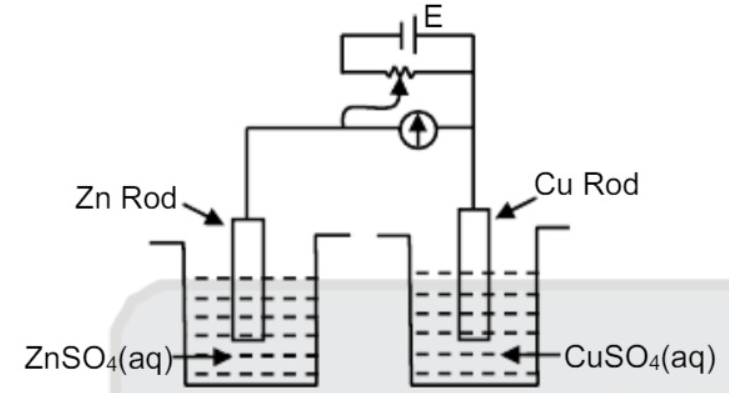For the cell :
Calculate the values for ,
(a) cell reaction,
(b)
(c)
(d) the minimum concentration of at which cell reaction is spontaneous if is ,
(e) does the displacement of goes almost to completion.
Given :
for
for
More is , more is tendency to show oxidation and thus will oxidize and will reduce.
Anode :
Cathode :
Cell reaction :
(b) Also,
(c) Also,
(d) Also,
Thus, if is for ,
so cell reaction is spontaneous.
or
or
or
(e) Yes, the displacement almost goes to completion.
Topper's Solved these Questions
- ELECTROCHEMISTRYBook:P BAHADURChapter:ELECTROCHEMISTRYExercise:(A) ELECTROLYSIS
Explore 2 Videos
- ELECTROCHEMISTRYBook:P BAHADURChapter:ELECTROCHEMISTRYExercise:(B) ELECTRODE POTENTIAL AND EMF
Explore 1 Video
- DILUTE SOLUTION AND COLLIGATIVE PROPERTIESBook:P BAHADURChapter:DILUTE SOLUTION AND COLLIGATIVE PROPERTIESExercise:Exercise 9 Advanced Numerical
Explore 12 Videos
- MOCK TEST PAPERBook:P BAHADURChapter:MOCK TEST PAPERExercise:Exercise
Explore 92 Videos
Similar Questions
If [Zn2+] is maintained at 1.0 M
(i) What is the minimum (Cu2+) for which the reaction
Zn(s)+Cu2+(aq)→Cu(s)+Zn2+(aq) is still spontaneous in formward direction.
(ii) Does the displacement of Cu2+(aq) by Zn(s) go to completion?
E0Zn2+/Zn=−0.76V
ECu2+/Cu=0.34V
View SolutionCalculate the potential of a Daniel cell, initially containing 1 litre each of 1M Cu2+and1MZn2+ after a passage of 1×105 coulombs of charge . E∘Cu2+,Cu=+0.34V,E∘Zn2+,Zn=−0.76V
View Solution
Knowledge Check
For the given cell arrangement identify incorrect statement
given E∘_(Cu2+/Cu) = 0.34V &E∘_(Zn2+/Zn)=−0.76V AIf Eext>1.1V,Zn dissolves at Zn electrode and Cu deposits at Cu electrodeBIf Eext>1.1V,e− flows from Cu to ZnCIf Eext<1.1V,Zn dissolves at anode and Cu deposits at cathodeDIf Eext=1.1V, no flow of e− or current occurs
AIf Eext>1.1V,Zn dissolves at Zn electrode and Cu deposits at Cu electrodeBIf Eext>1.1V,e− flows from Cu to ZnCIf Eext<1.1V,Zn dissolves at anode and Cu deposits at cathodeDIf Eext=1.1V, no flow of e− or current occursThe standard cell potential for the cell Zn∣∣Zn2+(1M)∣∣∣∣Cu2+(1M)∣∣Cu
Given E∘Cu2+/Cu=0.34V and E∘Zn2+/Zn=−0.76V isA1.10 VB−0.42VC−1.10VDNone of theseE∘ for the cell
Zn(s)∣∣Zn2+(aq)∣∣Cu2+(aq)∣Cu(s) is 1.1V at 25∘C the equilibrium constant for the cell reaction is aboutA10−37B1037C1073D1073
In the Zn-Cu cell, when the concentrations of Zn2+ and Cu2+ are unity, the e.m.f. is
View SolutionIn a cell reaction, Cu(s)+2Ag+(aq)→Cu2+(aq)+2Ag(s)E∘cell=+0.46 V . If the concentration of Cu2+ ions is doubled then E∘cell will be
View SolutionE∘ for the cell, Zn∣∣Zn2+(aq)∣∣∣∣Cu2+(aq)∣∣Cu is 1.10 V at 25 ∘C . The equilibrium constant for the reaction
Zn+Cu2+(aq)⇔Cu+Zn2+(aq)
is of the order of
View SolutionE∘ for the cell
Zn(s)∣∣Zn2+(aq)∣∣Cu2+(aq)∣Cu(s) is 1.1V at 25∘C the equilibrium constant for the cell reaction is about
View SolutionThe standard cell potential of Zn∣∣zn2+(aq)||Cu2+(aq)∣∣Cu cell is 1.10 V . The maximum work obtained by this cell will be __________.
View Solution